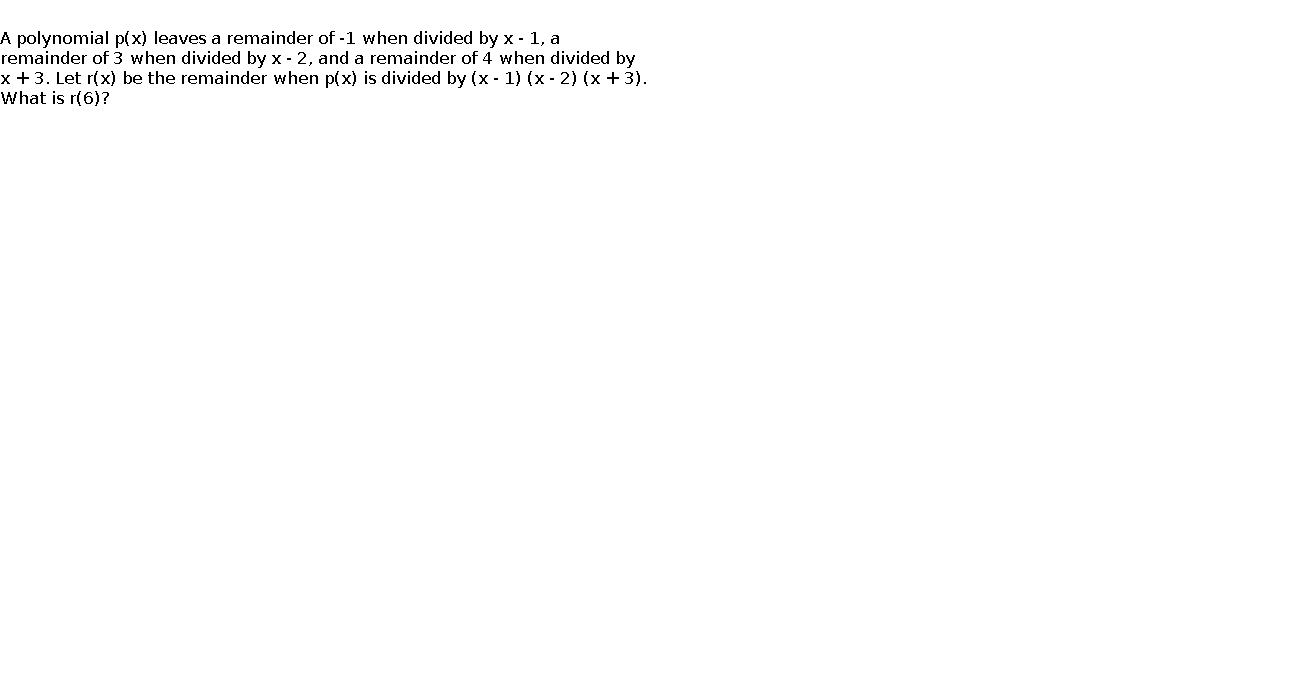Question Number 135624 by liberty last updated on 14/Mar/21

$$ \\ $$A polynomial p(x) leaves a remainder of -1 when divided by x – 1, a remainder of 3 when divided by x – 2, and a remainder of 4 when divided by x + 3. Let r(x) be the remainder when p(x) is divided by (x – 1) (x – 2) (x + 3). What is r(6)?
Answered by EDWIN88 last updated on 14/Mar/21

$$\mathrm{Let}\:\mathrm{p}\left(\mathrm{x}\right)=\left(\mathrm{x}−\mathrm{1}\right)\left(\mathrm{x}−\mathrm{2}\right)\left(\mathrm{x}+\mathrm{3}\right)+\mathrm{r}\left(\mathrm{x}\right) \\ $$$$\mathrm{with}\:\mathrm{degree}\:\mathrm{of}\:\mathrm{r}\left(\mathrm{x}\right)\mathrm{is}\:\mathrm{2} \\ $$$$\mathrm{and}\:\mathrm{r}\left(\mathrm{1}\right)=−\mathrm{1}\:;\:\mathrm{r}\left(\mathrm{2}\right)=\mathrm{3}\:\mathrm{and}\:\mathrm{r}\left(−\mathrm{3}\right)=\mathrm{4} \\ $$$$\mathrm{use}\:\mathrm{Remainder}\:\mathrm{Theorem}\: \\ $$$$\mathrm{we}\:\mathrm{get}\:\mathrm{r}\left(\mathrm{x}\right)=\frac{\left(\mathrm{x}−\mathrm{2}\right)\left(\mathrm{x}+\mathrm{3}\right)}{\left(\mathrm{1}−\mathrm{2}\right)\left(\mathrm{1}+\mathrm{3}\right)}.\left(−\mathrm{1}\right)+\frac{\left(\mathrm{x}−\mathrm{1}\right)\left(\mathrm{x}+\mathrm{3}\right)}{\left(\mathrm{2}−\mathrm{1}\right)\left(\mathrm{2}+\mathrm{3}\right)}.\left(\mathrm{3}\right) \\ $$$$+\:\frac{\left(\mathrm{x}−\mathrm{1}\right)\left(\mathrm{x}−\mathrm{2}\right)}{\left(−\mathrm{3}−\mathrm{1}\right)\left(−\mathrm{3}−\mathrm{2}\right)}.\left(\mathrm{4}\right) \\ $$$$\mathrm{therefore}\:\mathrm{r}\left(\mathrm{6}\right)=\frac{\left(\mathrm{4}\right)\left(\mathrm{9}\right)}{−\mathrm{4}}.\left(−\mathrm{1}\right)+\frac{\left(\mathrm{5}\right)\left(\mathrm{9}\right)}{\mathrm{5}}.\left(\mathrm{3}\right)+\frac{\left(\mathrm{5}\right)\left(\mathrm{4}\right)}{\left(−\mathrm{4}\right)\left(−\mathrm{5}\right)}.\left(\mathrm{4}\right) \\ $$$$=\:\mathrm{9}\:+\:\mathrm{27}\:+\:\mathrm{4}\:=\:\mathrm{40} \\ $$
